APAH: Ancient Rome
1/14
There's no tags or description
Looks like no tags are added yet.
Name | Mastery | Learn | Test | Matching | Spaced |
|---|
No study sessions yet.
15 Terms
essential knowledge of Etruscan and Roman art
Etruscan Art and Roman art is characterized by a pantheon of gods celebrated in large civic and religious buildings
Much ancient writing survives in the fields of literature, law, politics, and business. These documents shed light on Roman civilization as a whole and on Roman art in particular
etruscan art is known mainly through archaeology, literary tradition is mostly lost
etruscan: first major empire in Italy, not all Romans are Etruscan, but most of their culture is
there were numerous city states, but the art is studied as a single genre
etruscan art shows heavy Greek influence among other influences
roman art can be subdivided into the following periods: Republican, Early Empire, Late Empire, Late Antique
roman architecture shows an incredible deal of variety and willingness to experiment
roman art and architecture will be embraced in 17th century Europe
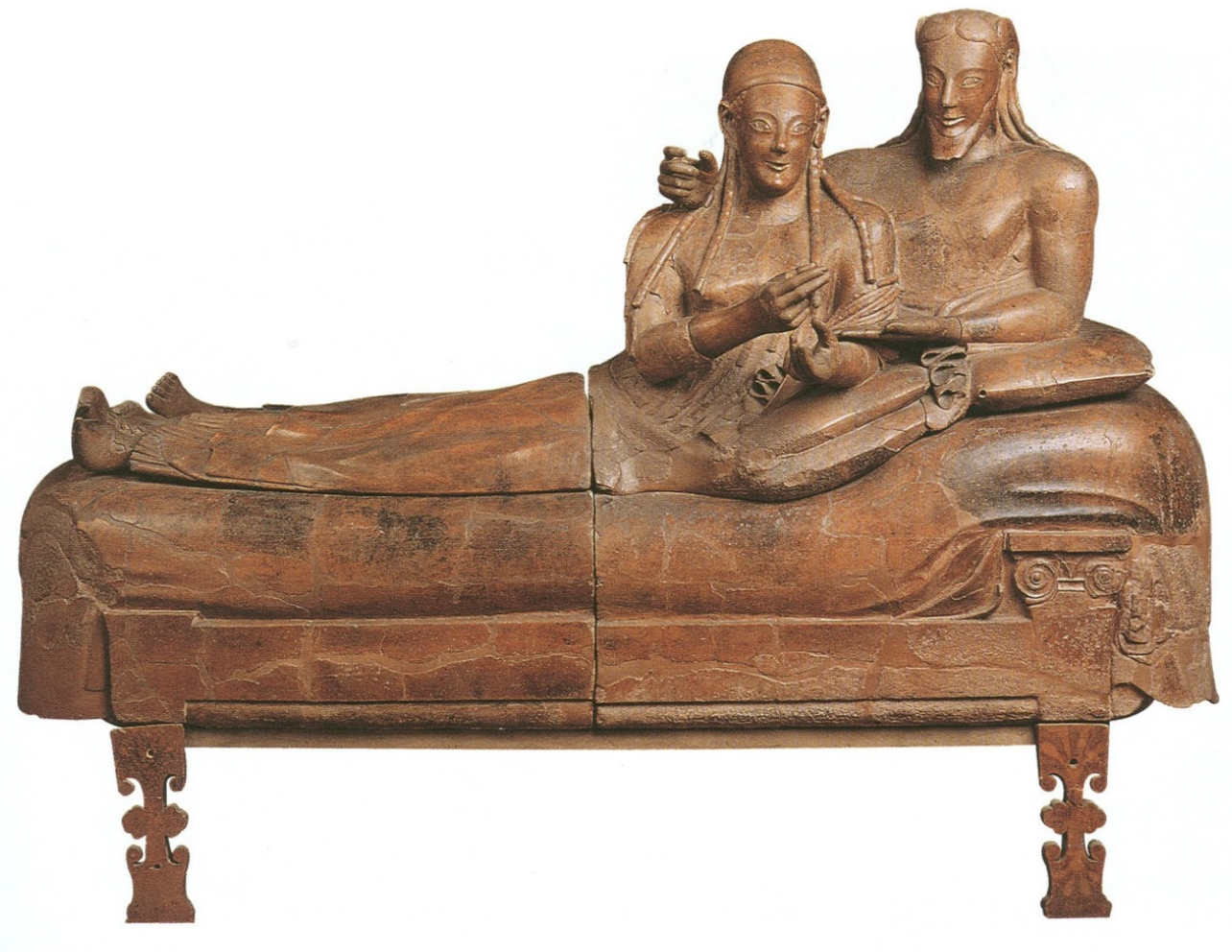
Sarcophagus of the Spouses: (Etruscan)
Cerveteri, Italy
terracotta
funerary
same time period as the Archaic period in Greece (appropriation)
Archaic smile
in ancient times, a man and woman being depicted together is very rare
women had higher status in Etruscan society
Sarcophagus of a married couple whose ashes are placed (likely high status, but not ruling/governing people)
affectionate
both holding the same thing, planning to feed each other
possibly an egg which was the Etruscan symbol for life after death
concentration and detail is on upper body, less on lower half
L shaped turn to the body, unrealistic

Temple of Minerva: (Etruscan)
Mud brick, wood
veii, italy
sacred space
Minerva: Athena in Italy
similar to Parthenon in how they both praise the same god
but the columns, pediment, and frieze are different
Vitruvius recorded the Temple of Minerva’s architecture in his writing
none of the Etruscan temples exist today, only his writings survive
three cell for three separate gods
highly influenced by Greek temples:
wood columns
capitals (tuscan order)
pediment
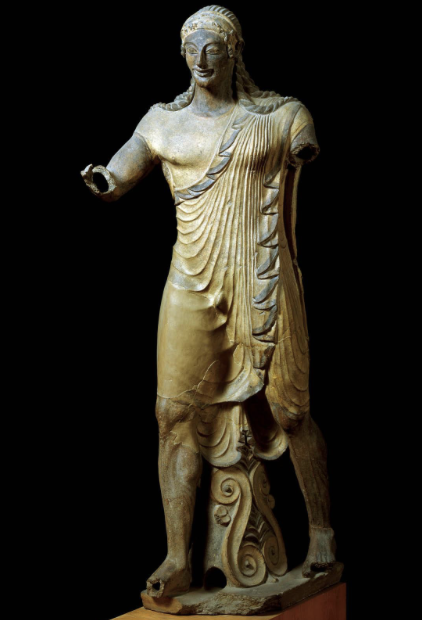
Apollo (Apulu): (Temple of Minerva at Veii; Etruscan)
terracotta
one of four sculptures that stood on the roof of the Temple of Minerva
strides forward more than Kouros
Archaic smile
may be in battle with Hercules
artists: could be Vulcan of Veii
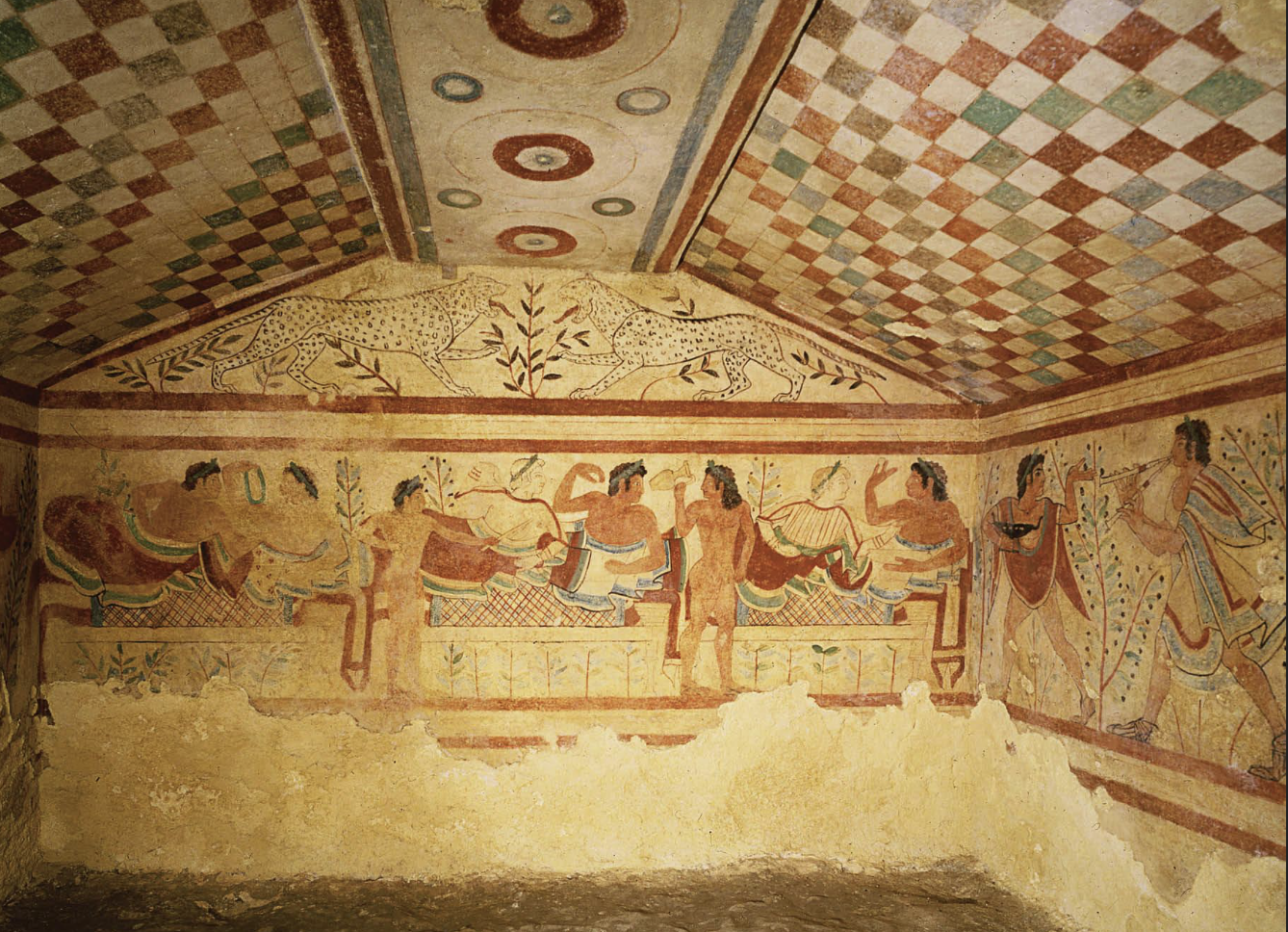
Tomb of the Triclinium: (Etruscan)
Tarquinia
tufa (mud brick) and fresco: takes white wet plaster, smear on wall, take dyed egg white pigments to paint fast while plaster is still wet
women are light-fair skinned (meant to be inside) while men are dark skinned (meant to be outside
appropriated from Greek
many tombs still exist, believed to be heavily influenced by Greek paintings (none exist)
piece is named after a dining table, one appears in the painting
ceiling = polychrome checkerboard pattern; circles = symbolize time
Etruscan funeral rites were festive and seen as a last time to enjoy a meal with the deceased before crossing over to the afterlife
overall the tomb suggests a celebration of the dead, dancing figures on the right and left walls, musical instruments
only Etruscan paintings that survive are funerary and on tomb walls

House of the Vettii: (1st Roman)
stone and fresco
Pompeii
Roman town home (villa = countryside, town home = city)
peristyle: four stoas and open sky
refuge of nature from the city; allows light into the garden but keeps town around them out
atrium: skylights where water would fall through to the basin underneath
axial plan: someone entering at the atrium can see the peristyle garden in the back
cubicula (rooms): on all sides of the atrium
heavy greek influence/appropriation
helps understand how Romans decorated their interiors
in triclinium (dining room) a number of paintings exist in good condition
three styles of Pompeian painting, this is the 4th style which combines all three
1: painted rectangular squares
2: large mythical scenes and landscapes
3: small scenes/ images set in a field of color and framed by columns
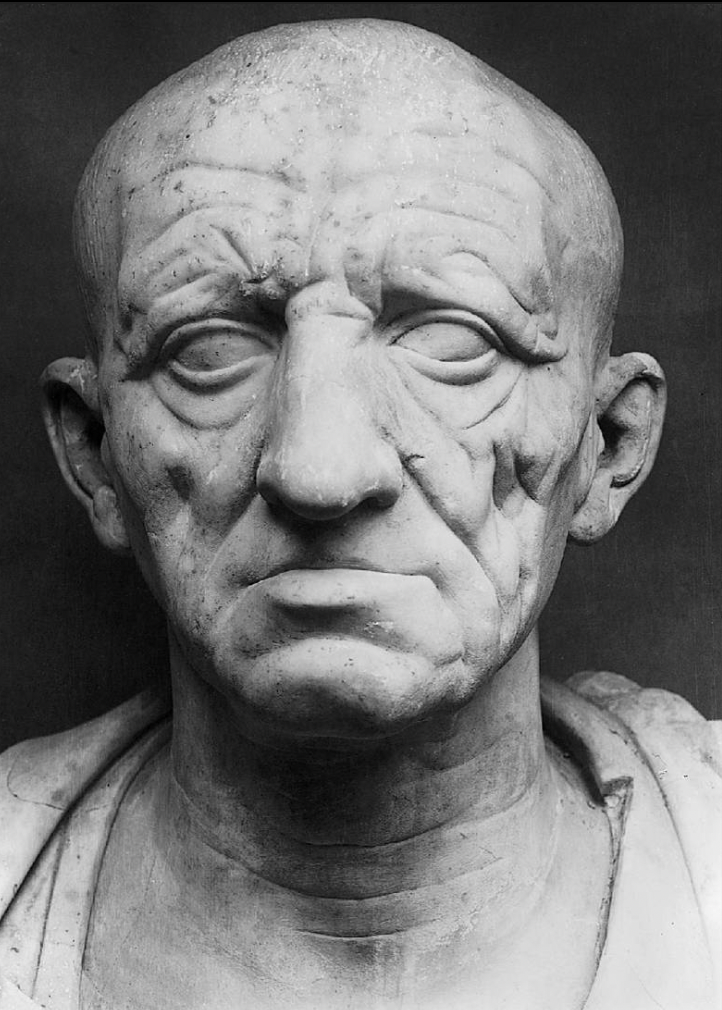
Head of a Roman Patrician: (Roman Republic)
marble
extreme realistic portrait called “Veristic”
influence of Hellenistic art of Greece
Roman patrician/senator (upper ruling class)
high status, but not idealized
did not want youthful and beautiful people running the government, wanted more experience (wisdom)
realism conveys a seriousness of a mind known to Romans as “gravitas”
Gravitas can only come with experience
youth was valued for beauty in arts, but not for governing authority
likely sculpted after death
only characteristic of Republic period

Augustus of Primaporta: (Roman Empire)
original was in bronze, in marble
first real roman emperor
sending message that their king was young, powerful, and strong
not showing age and wisdom, youthful strength
symbolizing that Augustus will bring a golden age to Rome (Pax Romana)
cupid: son of Venus, aligning with the gods, divine right
dolphin: naval battle that was won, ending civil war and establishment of Augustus reign
heavily appropriated from Canon of Polykleitos
contraposto pose
youthfulness, strong stetted out arm speaking to troops, stance and modeling after Doryphoros all point to a message of leader
cuirass (breastplate): covered in propaganda messages
Augustus has the gods on his side, he is a military victor, bringing of the Pax Romana lasting 200 years
message: sun will shine on Rome under the role of Octavian Augustus
purpose: propaganda to unite the empire after the civil war
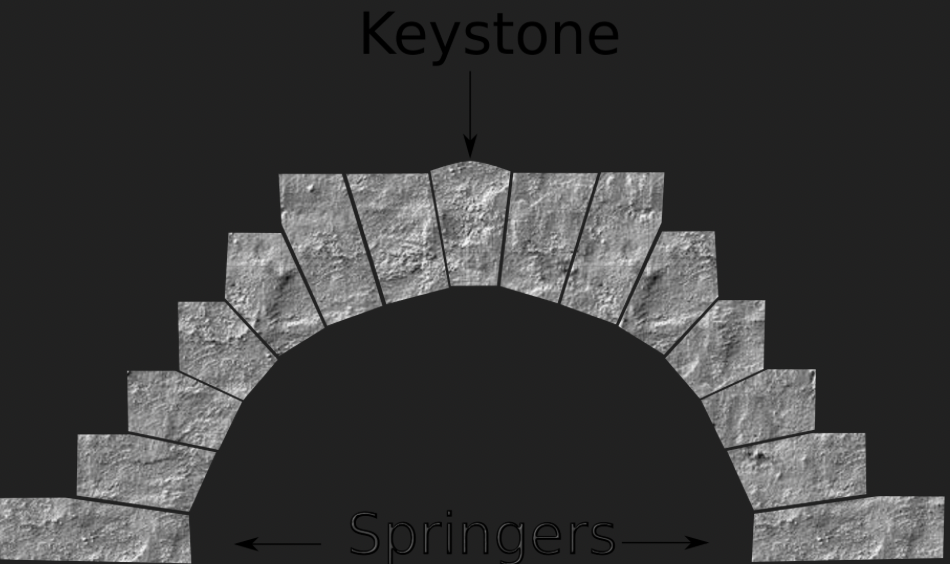
roman arches
improvement on post and lintels
can bare an extremely heavy load
arch: series of wedge shaped stones, smaller at the bottom and wider at the top, the wider top does not pass through a narrower bottom
allows major amounts of weight to rest on top
barrel vault: arch continues in a tunnel like fashion
groin vault: two barrel vaults intersect
romans will build enormous billings because they support an incredible amount of weight (colosseum, pantheon)
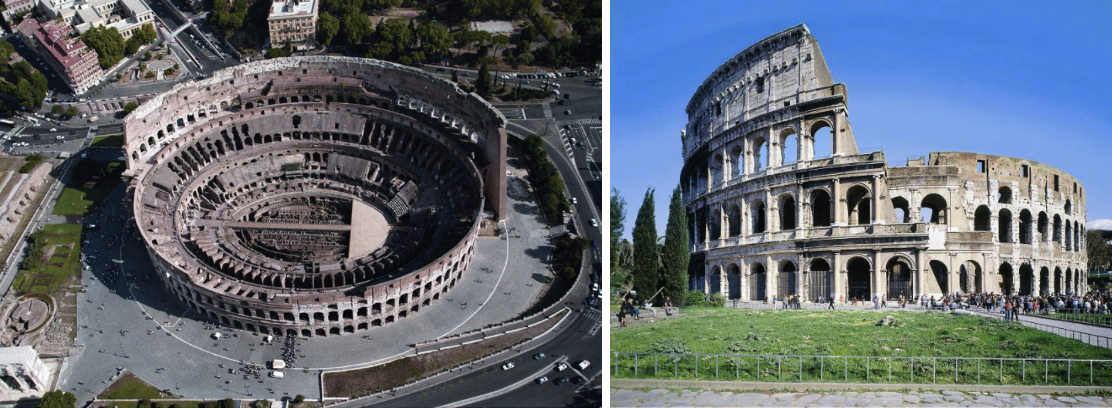
Colosseum: (Roman Empire)
stone, concrete, travertine
patrons: Emperors Vespasian and son Titus (Flavian Emperors)
vast barrel vaults and groin vaults
Rome was a multiethnic society
meant for entertainment/spectacles
gladiator combat
animal hunts
recreated battles
uniquely Roman, but putting two theaters into one is Greek
use of doric, ionic, and corinthian columns
1st story = tuscan, 2nd story = ionic, 3rd story corinthian
small square window looking holes at the top
understanding roman forums
“forums” were found throughout every major city in the empire. Essentially the same concept as a Greek agora
the forum in Rome was the most impressive
center of roman business and government (Athenian Agora)
locations for worship and sacrifice to the local gods
around the sides of the forums would be bathhouses, markets, and government buildings

Forum of Trajan: (Roman Empire)
architect: Apollodorus of Damascus
patron: Emperor Trajan
stone masonry with concrete (uniquely roman) and timber
forums for many emperors, this is Trajan’s forum
apse: half circle at the end of the basilica
basilicas were originally courthouses/government houses
has an axial plan
large central plaza surrounded by stoa-like buildings on each flank
sort of massive peristyle, not technically a peristyle
included Basilica of Ulpia and Markets of Trajan
Market:
multilevel mall like structure
semi circular interior was a series of groin and barrel vaulting
significant because it was another example of multi-storied architecture found in Rome like the Flavian Amphitheater
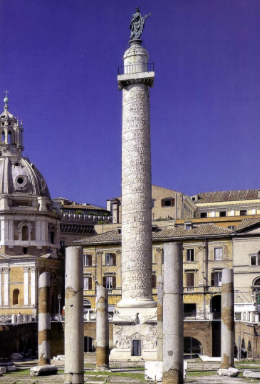
Column of Trajan: (Forum of Trajan; Roman Empire)
funerary, Trajan’s ashes are at the base of the column
stood behind the Basilica Ulpia between the Greek and Roman libraries
128 foot high narrative telling the conquering the Dacians
low relief to deter shadowing
2,500 different figures, 23 registers circling the column
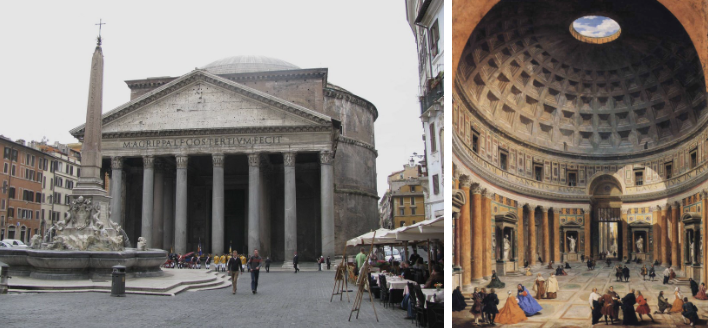
Pantheon: (Roman Period)
concrete with stone facing, granite, and pumice
original would have had two stoas on the side, a lot of steps leading to the entrance, would have not been able to see the circle from the outside
patron: originally Augustus and Marcus Agrippa but early structure destroyed
Pantheon built by Emperor Hadrian
corinthian capitals on portico (porch)
two pediments, one in front of the other
walls of the cupola (dome) are 20 feet thick at base and become thinner as they rise
oculus (opening at the top) 27 feet wide, allows for sunlight to move across the temple
roof-ceiling is pumice (light volcanic rock, floats) covered with concrete
interior is based on a circle
seven niches in the walls for statues of the gods
as Rome conquered more regions they wanted to honor the gods of the conquered (massive temple to all gods of the empire)
has an apse inside
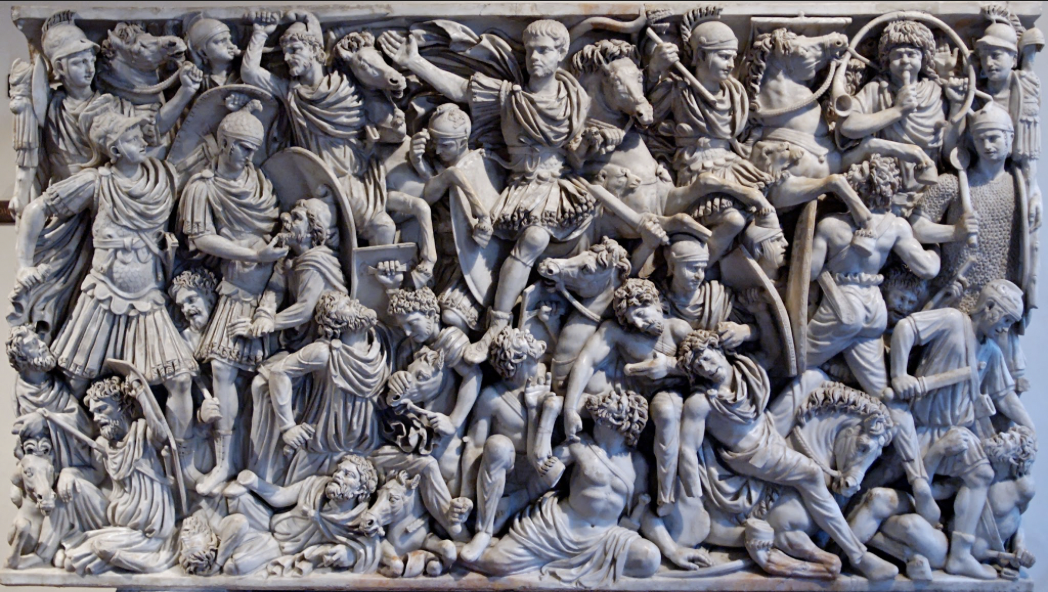
Ludovisi Battle Sarcophagus: (Roman Empire)
horror vacui: fear of open space
extremely crowded surface with figures piled on top of each other
Pax Romana is over
Barbarians: one who speaks another language (have beards)
Christianity is crowing, had a different burial practice (tomb with body intact)
prior to this, Romans always cremated
things are changing with barbarians coming in and different religious practices
Sarcophagus with a lid, has imagery all throughout it
figures lack individuality; expressing confusion of battle
Roman army defeats barbarians (Romans have no beards)
youthful Roman general at top center without weapons or helmet showing that he is invincible and needs to protection
significance: Pax Romana has ended and Rome is at war. Rome begins weakening. Influence of changes in religion, Christians kept the body intact, moving away from cremation